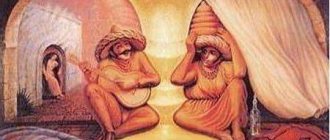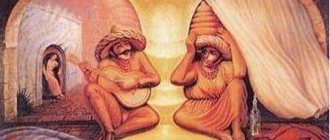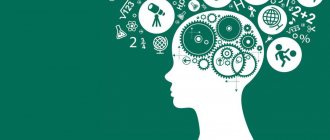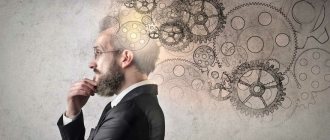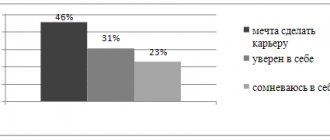Definition of cognition
What is cognition ?
This is a set of processes and methods through which you can gain knowledge about the world around you. This is a broad concept that covers both the natural desire to find a logical explanation for the processes occurring around us, and artificially created methods for obtaining and accumulating knowledge.
The desire to explain every phenomenon of the surrounding world is the main factor in the emergence and development of human civilization.
Structure of cognition:
- The subject is the one who performs actions aimed at obtaining knowledge. For example, you are reading this material to learn the types of cognition and their characteristics. It turns out that you are a subject of cognitive activity.
- An object is what the subject’s activity is aimed at. For example, now the object of your cognitive activity is the concept of knowledge and its types.
- Motives - why we do something. There are two types of motives:
- Practical motives push to possess knowledge in order to use it to improve the quality of life (studying at an institute gives a profession that feeds).
Theoretical motives are based on obtaining pleasure from the process of cognition itself (read a book and expand the library of your knowledge).
- The purpose of cognitive activity is to obtain true, reliable knowledge about the world, to understand how reality actually works.
- The result is the very knowledge about an object or phenomenon. Sometimes the result occurs unconsciously, for example, if a child plays with a clay mug and breaks it, he will immediately understand that the clay is fragile and will handle the dishes more carefully.
Now we will find out what methods of cognition exist, and then we will move on to forms.
Introduction
Sensory knowledge is the first available to a person, and it is this that forms a three-dimensional understanding of the world around us. This work will examine the issue of sensation and perception, the primary stages of human cognition.
The relevance of this issue cannot be overestimated, since everything we know about what surrounds us comes to us precisely through sensation and further perception. The important point here is that the world around us that we are aware of does not always correspond to the real world, which is caused by errors of perception and sensation. In order to understand the methodology for forming the image of an object and the world as a whole, one should turn to the basic concepts and properties of the objects considered here.
The purpose of the work is to consider the essence of the concepts of sensation and perception; to reveal it, the following tasks are set: establishing a classification of concepts, identifying their properties, establishing patterns of their manifestation, considering the basic principles of action.
One of the tasks of the work is a test aimed at consolidating the knowledge acquired during the work on the test, as well as checking how well the material has been learned.
Methods of cognition
All methods of knowledge can be divided into two large groups: empirical and theoretical.
Empirical methods are the identification of objective facts, as a rule, from their obvious connections.
Theoretical methods are the identification of fundamental patterns, the discovery of hidden manifestations behind the visible ones, internal connections and relationships.
Empirical methods:
- Observation - the researcher studies an object in its natural environment without influencing the ongoing processes.
- Measurement - the researcher obtains the numerical characteristics of the object through which he is observing and compares its properties with standard values.
- Experiment - the researcher deliberately creates special conditions and then studies the object that he places in them.
- Classification - the researcher combines the objects being studied into groups according to the same properties.
- Systematization - the researcher combines accumulated knowledge into a system in which relationships and patterns are indicated.
- Description - the researcher records information about objects and data in the observation using natural or artificial language.
- Comparison - the researcher compares the properties of the object he is studying with the properties of other objects.
Theoretical methods:
- Historical method - the researcher studies history in its entirety, generalizes empirical material and establishes a general historical pattern on this basis.
- Ascent from the concrete to the abstract is a method in which the researcher first finds the main connection, and then, step by step, observes how it changes in different conditions and discovers new connections.
- Ascent from the abstract to the concrete is a method of studying reality, the essence of which is a consistent transition from abstract and one-sided ideas about it to a more concrete reproduction of it in theoretical thinking.
- Formalization is the construction of abstract mathematical models that reveal the essence of the processes being studied.
- Mathematization is the application of methods and concepts of mathematics in the natural, technical and socio-economic sciences for the quantitative analysis of the phenomena that they study.
There are also general scientific methods of cognition. Among them are:
- Analysis - dividing an object into components and studying it in detail.
- Synthesis is the reconstruction of a complete picture from individual parts.
- Analogy is a method of cognition in which, based on the similarity of objects in some characteristics, they conclude that they are similar in other characteristics.
- Specification is a deeper study of certain properties.
- Abstraction is the study of a subject from a new angle (with an emphasis on some properties and ignoring others).
- Induction is inference that is directed from the particular to the general.
- Deduction is inferences that are directed from the general to the specific.
- Idealization is the creation of an image of a fictional object with ideal properties and using it as a special example.
- Modeling is the creation of a model of an object for a detailed study of its properties, which is impossible on a real object.
Cognition has two levels (stages): sensory and rational. Let's consider each of them separately.
We will help you consolidate new material in social studies courses at the Skysmart online school.
Imagination
As stated above, imagination plays a very important role in the process of representation. It is thanks to imagination that our sensations acquire meaning that you understand. But imagination itself is not a product of the activity of the senses. Imagination is a product of transformation of the functional characteristics of display.
Photo by Kevin Bidwell from Pexels
If you look at geometric shapes drawn on paper, without imagination they will just be shapes to you. But as soon as you use your imagination, which is based on your knowledge and experience, the figure immediately becomes three-dimensional.
Sensory cognition
Sensory cognition occurs through the human senses. The main mechanisms of sensory cognition: vision, hearing, smell, touch, taste.
Forms of sensory knowledge:
- Sensation is a reflection of the individual properties of an object, phenomenon, process that arise as a result of their impact on the senses. With the help of these organs, a person perceives some properties of an object - shape, color, smell.
- Perception is a sensory image of a holistic picture of an object, process, phenomenon that affects the senses. It is perception that helps form ideas.
- Representation is a sensory-visual, generalized image of an object, process, phenomenon, which is preserved and reproduced in consciousness even without the influence of the objects of knowledge themselves on the senses. In other words, what is retained in a person’s memory after becoming familiar with the subject.
Sensory cognition is always subjective, and it is this level of cognition that realizes a person’s connection with the outside world.
Sensitive cognition occurs in three main forms: sensation, perception, and representation.
Feeling
- this is a reflection of individual, sensory properties of objects of the material world: color, shape, smell, taste, sound.
Perception
– is a complex of sensations; a holistic image of an object that arises as a result of its direct impact on the senses. For example, perception, the image of an apple being eaten.
Performance
– this is a reproduction of what was previously perceived; This is a sensory image of an object preserved in consciousness that was perceived before.
Representation exists when the direct impact of the object on the senses is no longer present. In representation, to a greater extent than in sensations and perceptions, the active nature of sensory cognition is manifested, since representations can be not only reconstructed images of real objects. They can be formed on the basis of description, imagination, conjecture of objects that do not exist in reality. For example, the representation of the image of a centaur from ancient Greek mythology.
So, sensation, perception, representation are forms of sensory knowledge. However, sensory knowledge gives us knowledge only about the external properties of objects, about individual concrete things. A person cannot limit himself to such knowledge. He strives to generalize perceptions and ideas, to penetrate into the essence of things and processes, to understand the laws of nature and society. And this is impossible without abstract thinking, which constitutes the second stage of knowledge of reality, the stage of logical knowledge.
Note: abstraction (from the Latin word abstractio - distraction) is the result of the process of abstraction, that is, abstraction from some properties of an object and highlighting its other properties. Abstract thinking is thinking that operates with abstractions. Examples of abstractions: person, housing, weapons, food, etc.
Let us consider the main features of abstract thinking (the logical stage of cognition).
First. Unlike sensory cognition, thinking abstracts from the individual and identifies the general, repetitive, and essential in objects. For example, by identifying in different people the properties of working, thinking, and exchanging thoughts using language as common to all, we generalize these properties and create an abstract image of a person.
Note: generalization is the extension of certain particular characteristics to the entire set of objects and phenomena under consideration; it is a transition from the individual to the general; This is the identification of patterns.
Thus, thinking reflects reality in generalized images.
Second. Thinking is a process of indirect reflection of reality. It is mediated by sensory knowledge.
Third. The inextricable connection between thinking and language. Any thought can exist only on the basis of language. Language is the immediate reality of thought.
Fourth. Thinking is a process of actively reflecting reality. By creating abstractions, a person transforms objects of the objective world in his consciousness, reflects them in the form of ideal images with the corresponding ideal adjustment.
The main forms of abstract thinking are concept, judgment, and inference.
Logical form, or form of thinking
- this is a way of connecting parts of the content of a thought, its structure, thanks to which the content exists and reflects reality.
Concept
is a form of thinking that reflects objects in essential features. In this case, the attribute of an object is that in which objects are similar to each other or in which they differ from each other.
Concepts reflect individual objects or their combinations. For example: “man”, “law”, “form of thinking” are concepts.
Judgment
- this is a form of thinking in which the connection between an object and its attribute or the relationship between objects is affirmed or denied and which has the property of expressing either truth or falsehood.
Examples of judgments: “The accused has the right to defense”, “A person who commits a crime while intoxicated is not exempt from criminal liability.”
The standard formula for a judgment is as follows: SP, where S is the subject (the concept of the subject of the judgment), P (predicate) is the concept of the attribute of the subject, the “hyphen” sign indicates an affirmative (is) or a negative (is not) connection between S and P For example, Ivanov is a coach.
Inference
- a form of thinking through which a new judgment is derived from one or more judgments.
Any conclusion consists of premises, conclusion and conclusion. Premises are the initial known propositions. A new judgment is called a conclusion. The logical transition from premises to conclusion is called a conclusion.
For example: a judge cannot participate in the consideration of a case if he is a victim (1st premise). Judge N. – victim (2nd premise). This means that he cannot participate in the consideration of the case (conclusion).
It is easy to see that propositions - premises must have a general concept. In this example, this is the concept of “victim”. Only then is a conclusion possible.
Another example: all sports judges must be masters of sports. Consequently, no sports judge can fail to be a master of sports. This is an example of so-called direct inferences.
In each of the considered forms of thinking (concept, judgment, inference) there is something common that does not depend on the specific content of thoughts, namely: the way of connecting parts of the content of thought - features in the concept, concepts in the judgment and judgments in the inference. So, the subject of research here is the very form of thinking or logical form. If the connection between thoughts in the process of reasoning acts as an internal, necessary, essential connection, then we have before us the law of thinking.
For example, the law of identity states that a thought in the process of reasoning must have a definite, stable content and not be replaced by other thoughts.
The philosophical science of the forms in which human thinking occurs and the laws to which it is subject is called logic.
Thus, the subject of logic as a science is human thinking as a means of cognition, laws, forms, and methods of thinking.
__________
If logical correctness is observed in the reasoning process,
that is, reasoning corresponds to the forms and laws of logic, but the content of thoughts itself is not true, then no logic will provide the correct result. Take, for example, the following conclusion:
P. All mammals are cows.
P. Lions are mammals.
_____________________________
Z. Lions are cows.
Logical correctness is observed here, but the conclusion as new knowledge is untrue, because it does not correspond to reality (like the first premise).
True
is interpreted as the correspondence of knowledge to reality, as an adequate reflection of the object by the knowing subject. In this regard, truth is endowed with a number of fundamental properties: objectivity, relativity, procedurality, concreteness.
The structure of knowledge can be divided into two layers:
• one layer depends on the specifics of the biological and social forms of movement of matter, the organization of a person, his nervous system, brain, methods of processing information, the uniqueness of a given culture and language;
• the other layer depends on objective reality, on the specifics of phenomena and processes reflected by cognition.
arises :
Can we identify content in our knowledge that does not depend on either an individual person or humanity, and if we can, then how, how can we determine the degree of correspondence of this content to objective reality?
Before Marxism, two ways of separating the objective and independent content of our knowledge developed:
• logical-theoretical
(logical analysis and theoretical reasoning). For example, Plato believed that only knowledge about eternal and unchanging ideas can be true;
• sensory-empirical.
However, pre-Marxian materialism, taking the position of this method, could not solve the problem of the truth of abstract knowledge, for example, mathematical truths. How, say, can we establish or verify the truth of multidimensional geometry if the actually observed physical objects are three-dimensional? Moreover, sensory images are subjective.
Hence the identification of two main criteria of truth: rationalistic
(correspondence of new knowledge to other knowledge, theoretical system) and
empirical
(correspondence of knowledge to the testimony of the senses).
To these criteria one more criterion is added - the criterion of the usefulness of knowledge
(for example, the philosophy of pragmatism claims that the criterion for the truth of knowledge is its usefulness).
The real revolutionary revolution in the theory of knowledge, accomplished by the dialectical materialism of Marx and Engels, lies not in the fact that it combined observation and intellectual activity, which were often opposed to each other, in one formula, but in the fact that it fundamentally changed the very formula of knowledge. If earlier the process of cognition was considered according to the formula (scheme): object (external world) - subject (person), now the scheme of cognition has acquired the following form: object - objectively practical activity (practice) - subject.
All characteristics of truth began to be considered from the point of view of changing, developing practice - the main or main criterion of truth. All other criteria have become secondary.
For socio-historical practice, there is nothing absolutely objective in the content of knowledge that does not include social and individual human consciousness.
We cannot have any knowledge of the objective world that is not included in our practical activities. Objectivity of truth,
therefore,
it is not absolute, but relative
.
Truth is relative because:
1. The objective world, reflected in knowledge, is constantly changing and developing.
2. The practice itself changes and develops.
3. Knowledge is developed and refined, growing on the basis of practice and tested by it.
Thus, objective truth is in a process of constant change and development. The very objectivity of truth should be viewed through the dialectic of the absolute and the relative.
Now let us define the main characteristics of the truth of knowledge.
Objectivity of truth
- this is its independence from human consciousness, cognition, but not from human practice. In addition, truth is objective in its content. In its form, truth is subjective, since it is a property of human knowledge.
The processuality of truth lies in the fact that truth is a dynamic formation, truth is a process.
The Relativity of Truth
- this is the incompleteness of knowledge at each stage of cognition, depending on the development of the world, practice, knowledge.
Absoluteness of truth
- this is the unattainable limit of completeness and accuracy of knowledge about the world, this is the unattainable goal of human knowledge.
The concreteness of truth lies in the fact that it is received by the subject of cognition in certain conditions, characterized by the trinity of place, time, action. There is no such thing as abstract truth.
The opposite of truth is a lie,
which comes in two forms:
• as a deliberate, deliberately incorrect statement or denial;
• as a distorted reflection of reality, that is, delusion.
The opposite of truth is error
is a one-sided, illusory reproduction of reality. Unlike intentional lies, delusion is an unintentional distortion of reality. Misconceptions can lead to the creation of problematic situations that require a true theory and the establishment of the limits of applicability of the latter. This is why the criteria of truth are used, this is why science exists.
_____________________________
Society (society)
– integrative, unifying quality of life of people; the systemic existence of humanity, developing according to its own laws, which have material characteristics, but also its own specificity in comparison with the laws of nature.
Society, at the same time, acts as both a holistic entity and a complex hierarchically dissected object within itself. The social hierarchy includes large social communities, sets - classes; medium and small communities, multitudes, associations of people - social groups. Classes and social groups included in them or occupying an intermediate position have their own objective interests, which consist in satisfying the aggregate needs of their social base. At the same time, these interests are expressed not by a class or social group as a whole, but by some of the most active, selected groups: the party leadership, the ruling elite, the top of professional groups, etc. Thus, in social laws, which find their expression in the activities of social groups, the dialectic of the general and the particular, the public and the personal, the objective and the subjective is embodied. Considering the multiplicity of coexisting classes and social groups, we can say that social laws act as laws - trends, and the direction and dynamics of the socio-historical process are determined by the resultant of these trends.
The speed and intensity of the action of laws - trends in different periods of social development are also different. In contrast to the measured, unhurried flow of social time during evolutionary periods, the speed and intensity of the action of laws - trends, the intensity of their contradictory interaction and opposition intensify and increase during periods of social revolutions, that is, fundamental changes in the entire system (set) of social relations. The law of alternation of evolutions and revolutions is a fundamental law of society and an illustration of the operation of the laws of dialectics.
Social existence
– these are the real conditions of the material and spiritual life of people. This existence is systemic, but complex and multifaceted, includes several levels - factors associated with various types of social relations and activities.
Social consciousness
is a cumulative reflection, an ideal image of these conditions, both in the heads of people and in the noosphere (the sphere of ideas and ideal formations, constructions, such as scientific theories, works of art and images, moral, political and legal norms, religious beliefs, philosophical concepts, etc. .d.).
Social existence and social consciousness are closely connected and are capable of mutual transformation, mutual transition. This connection, mutual transformation is possible thanks to socio-historical practical activity and is carried out only and exclusively in it, through it.
With all the complexity of the relationships of mutual influence and mutual generation of social being and social consciousness, mediated from each other by socio-historical practical activity (practice), the primacy of social being, the secondary nature and activity of social consciousness are postulated.
Society, like living nature, is a systemically organized entity. Systematic social organization
can be traced both vertically and horizontally; both in the process of socio-historical development, and in the sense of the hierarchy of coexisting levels - factors of social existence - consciousness.
Any complex system includes a set of components (composition); the set of relationships between these system components (structure), including the relationships of subordination of various levels of sets of components (hierarchy); complexes of control mechanisms; system-forming factor or integrative property (properties). Society as a social system contains all of these components.
If we consider society from the point of view of its horizontal section or at a time, then the social system includes several hierarchically subordinate levels: economic, social, political, legal (legal), level of art (artistic), religious, philosophical. Each level, in turn, consists of total relations and activities (structure), total social institutions, organizations, institutions (composition). Social institutions (organizations, institutions, enterprises) represent a stable state of social (in the broad sense of the word) relations of a given level, which have received an object-material embodiment. Such a stable state of social relations or their institutionalized state is called the organization of society. Accordingly, we can distinguish economic, social (in the narrow sense), political and other organizations of society at various levels.
Of all single-level control mechanisms (relations used as basic, administrative, having the highest priority for the entire set of derivative, subordinate relations of a given level), the main ones are considered to be relations regarding the existence of a system-forming factor of one level or another. The latter constitute the essence of system-forming properties. For example, for the production and economic level of society, the system-forming, integrative factor is the form of ownership of the means of production (land, industry), and the system-forming, integrative properties are relations regarding ownership of the form of ownership; economic structure and composition - a set of elements or components of the economic organization of society (economic institutions, organizations, institutions, enterprises) that are in certain hierarchical relationships with each other; governing mechanisms - relations on issues of management, interaction, determining the foundations of the functioning and development of economic institutions; and economic consciousness is a set of economic theories, norms, rules, etc., that is, a set of various ideal images that are the result of reflection and awareness of economic existence, both in the heads of people and embodied in their activities and in the functioning of economic institutions.
Another example: the political level. For the political level, the integrative factor is political power; system-forming properties - relations on the issue of possessing political power; political organization of society - political composition (state, parties, etc.) and political structure (respectively, political relations and activities - politics); political management - relations regarding the administration of legislative, executive and judicial power or relations regarding the issue of domination and subordination; political consciousness - political doctrines. Political theories, views that exist both at the level of individuals - politicians and ordinary people, and at the level of the political part of the noosphere or in the form of norms for the functioning of the political organization of society are reflected by the concept of “political consciousness”.
Various levels of organization of social, production (in a broad sense) practice (economic, political, legal, etc.) are also called spheres of public life.
Despite the importance and activity of any sphere, their role in the general multi-level hierarchy of society is not equivalent.
The determining factor is the production and economic sphere, called the basis.
Adjacent to it is the social (in the narrow sense) sphere, which unites large aggregates, masses of people differing in nationality, gender, age, territorial state, professional, ethnic or other demographic characteristics.
The spheres of art, religion, philosophy constitute the so-called superstructure,
determined by the basis, but also having an active reverse influence on it. The spheres of the ideological superstructure also include education and sports, which are, however, closer to the socio-economic base and to the political sphere. The political sphere of public life acts as a concentrated expression of socio-economic interests and relations. It occupies an intermediate place between the base and the superstructure, determining the general dynamics of the development of the latter.
The superstructure, being removed and separated from the direct influence of the socio-economic base, is to a greater extent idealized and therefore has a certain independence, allowing it to maneuver between different types of socio-economic formations, creating redundant ideal structures - images, adapting to several coexisting or replacing each other's formations.
There are several types of socio-economic formations,
vertical sections of the socio-historical process, if we consider them abstractly and logically, that is, according to the degree of development. The basis for dividing formations into types is the method of production in the unity of productive forces and production relations: primitive communal, slaveholding, feudal, capitalist, socialist. An indicator, an indicator of the type of formation is its main classes, the existence of which is determined by the corresponding method of production: community members, slave owners and slaves, landowners - feudal lords and peasants, capitalists and workers.
Certain, even significant difficulties in identifying class divisions arise when interpreting the socialist mode of production. Marx himself, in his fundamental work “Economic and Philosophical Manuscripts of 1844,” understands socialism as the highest, developed level of capitalism - the level of transnational corporations, the level of super-monopoly associations. From this point of view, socialism is not what existed in the USSR and in the countries of the socialist community, but what is developing today in Western European countries, in Japan and the USA. Apparently, a large role in the social differentiation of people under socialism is played (along with the method of production) by the place they occupy, which is more or less stable, but capable of changing their position in the socio-economic hierarchy, as well as professional affiliation (theories of social groups, stratification , social mobility).
In the process of his practical activity in interaction with nature, man transforms its natural existence and creates a kind of artificial existence called culture.
Culture is interpreted as a reality and a concept that reflects the real totality of processes, results and carriers of all forms of social subject-transforming, production (in the broad sense of the word) relations, that is, as a unity of economic, socio-demographic, political, legal, artistic, religious, philosophical and other spheres of society. In this sense, the concept of “culture” is equivalent to the concept of “society”.
In a narrower sense, culture means the mechanism and totality of all the most stable traditions of human existence, transmitted from generation to generation, ensuring the reproduction of the conditions of social existence, the complex of social relations and the people themselves as bearers of these relations. A person, in the process of his social-production practical activity, constantly reproduces the traditional framework of society and himself as a type of personality, as a social being. With this understanding, culture acts as an integrative, system-forming factor for society as a whole, as its cementing basis.
Culture, in the process of its formation and development, underwent three main states, corresponding to three successive historical eras:
· era of savagery;
· era of barbarism;
· era of civilization.
The classics of Marxism borrowed this concept from the famous ethnographer and historian Lewis Henry Morgan [see. Engels F., t. 21, p. 23-178].
Age of Savagery
- this is the dawn of humanity, covering a huge period of time and ending with the first socio-historical division of labor, that is, the separation of hunting from gathering.
The era of barbarism,
that is, the era of primitive communal and tribal, pre-state social structure took much less time. It lasted until the second and third socio-historical division of labor, that is, until the separation of cattle breeding from agriculture and the separation of crafts from agriculture.
Age of civilization,
in turn, covers a much smaller period of historical time even in comparison with barbarism.
This is the era of the existence of states, although each more developed and more mature state,
forming a more ancient and developed
civil society,
the ethnic community considers representatives of all other younger states and their ethnic groups to be barbarians. For example, the ancient Greeks considered the Romans to be barbarians, and the Romans called barbarians all the peoples that they conquered and were not part of the “Roman world” (a barbarian, translated from Latin, is a person who wears a beard).
In this context, civilization as a state design of social life is opposed to civil society or culture.
Thus, here civilization and culture are considered as form and content, exerting mutual, but not entirely equal, influence on each other with an emphasis in favor of statehood (civilization).
The classics of Marxism were confident that society, in the process of cultural development, would get rid of civilization, from the state machine of suppression of the majority by the minority. They called this perspective for the development of society communism [
Marx K., vol. 42, p.
41-174 ].
Rational cognition
Rational knowledge is carried out by reason. It is unique to humans and is a rather complex way of reflecting reality.
Basic mechanisms of rational cognition: comparison, assimilation, generalization, distraction.
Forms of rational knowledge:
- A concept is a thought that asserts the general and essential properties of an object.
- A judgment is a thought that affirms or denies something about an object.
- Inference (conclusion) is the mental connection of several judgments and the derivation of a new judgment from them.
An example of an inference: if a > b and b > c , then a > c .
Types of inferences:
- Inductive inference - from the particular to the general.
- Deductive reasoning - from the general to the specific.
- The one that is obtained by analogy.
A little more about the properties of sensations
There are 5 properties of sensations, each of which is important:
- Intensity
Shows how much the stimulus affects the nervous system and the functional system of the stimulus.
Photo by Paul Kerby Genil: Pexels
- The sensations do not disappear immediately.
What you feel may last for a while, but it is usually short-lived.
- The feeling does not appear immediately.
There is a latent period between the onset of the stimulus and the appearance of the sensation itself.
- Quality.
This is the main feature of the sensation. Varies within a given sensation.
- Duration.
This depends on the functional state of the receptor itself. The time during which the stimulus acts and with what intensity.
Comparison of sensory and rational cognition
| Sensual | Rational |
| Immediacy, which is expressed in the direct reproduction of the object. Visibility and objectivity of images arising as a result of cognition. Reproduction of external aspects and properties of objects. | Reliance on the results of sensory cognition. Abstractness and generality of images arising as a result of cognition. Reproduction of objects based on internal regular connections and relationships. |
It is impossible to oppose the sensual and rational in knowledge. Both stages appear as a single process. The difference between them is not temporary, but qualitative: the first stage is lower, the second is higher.
Bibliography
- General psychology: cognitive processes: textbook / V.M. Kozubovsky. — 3rd ed. - Minsk: Amal-feya, 2008. - 368 p.
- Kravchenko A.I. Psychology and pedagogy: Textbook. - M.: INFRA-M, 2008. - 400 p. - (Higher education).
- Electronic resource: https://repository.vzfei.ru
- Electronic resource: https://ru.wikipedia.org
Attention!
If you need help writing a paper, we recommend turning to professionals. More than 70,000 authors are ready to help you right now. Free adjustments and improvements. Find out the cost of your work
Free estimate
0
Size: 16.43K
Downloads: 153
03/29/14 at 10:21 Author: van4ess
Liked? Click on the button below. It's not difficult for you
, and we
are pleased
).
To download test papers for free at maximum speed, register or log in to the site.
Important! All submitted Tests for free downloading are intended for drawing up a plan or basis for your own scientific works.
Friends! You have a unique opportunity to help students just like you! If our site helped you find the job you need, then you certainly understand how the job you add can make the work of others easier.
Add a job
If the Test work, in your opinion, is of poor quality, or you have already seen this work, please let us know.
